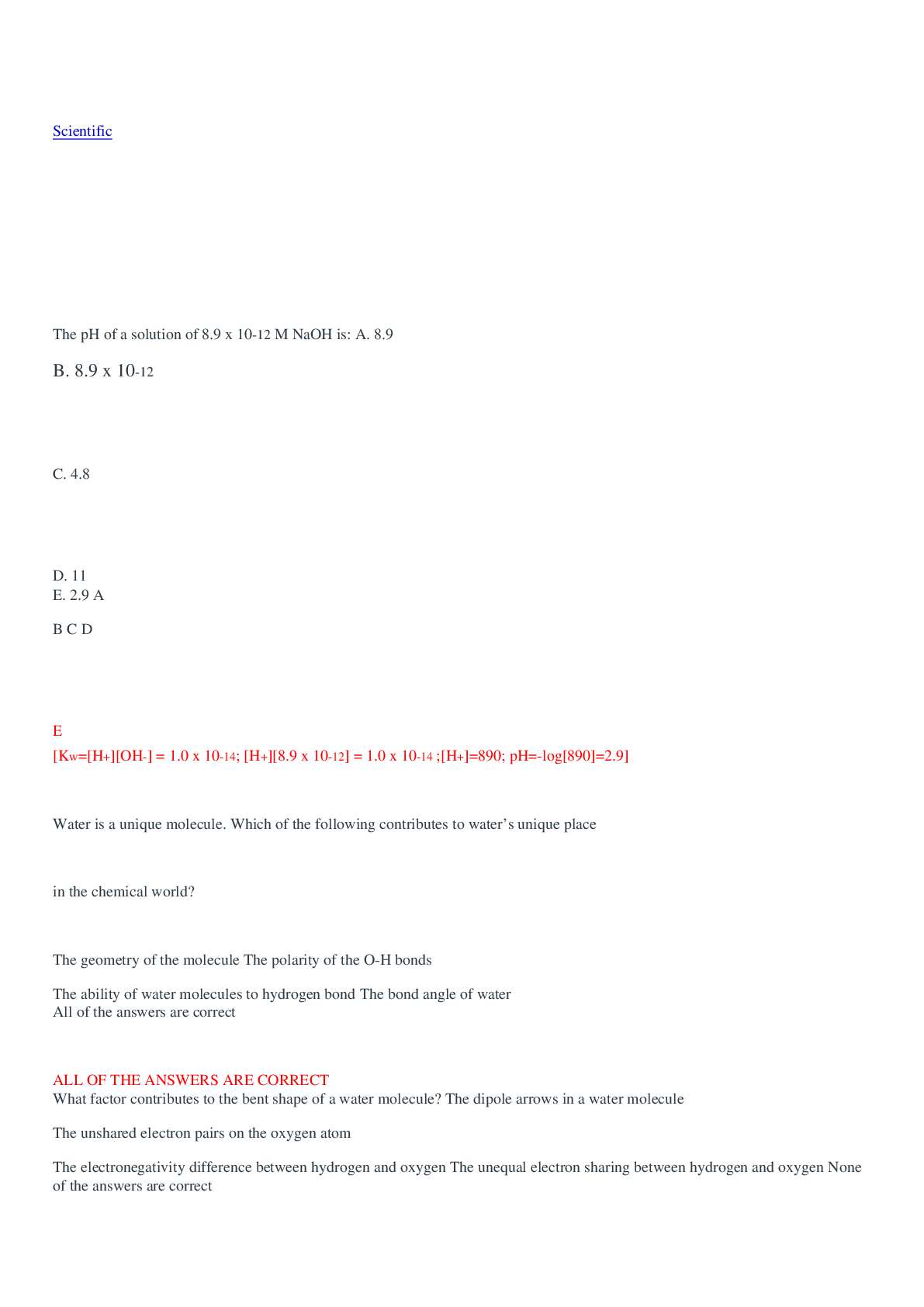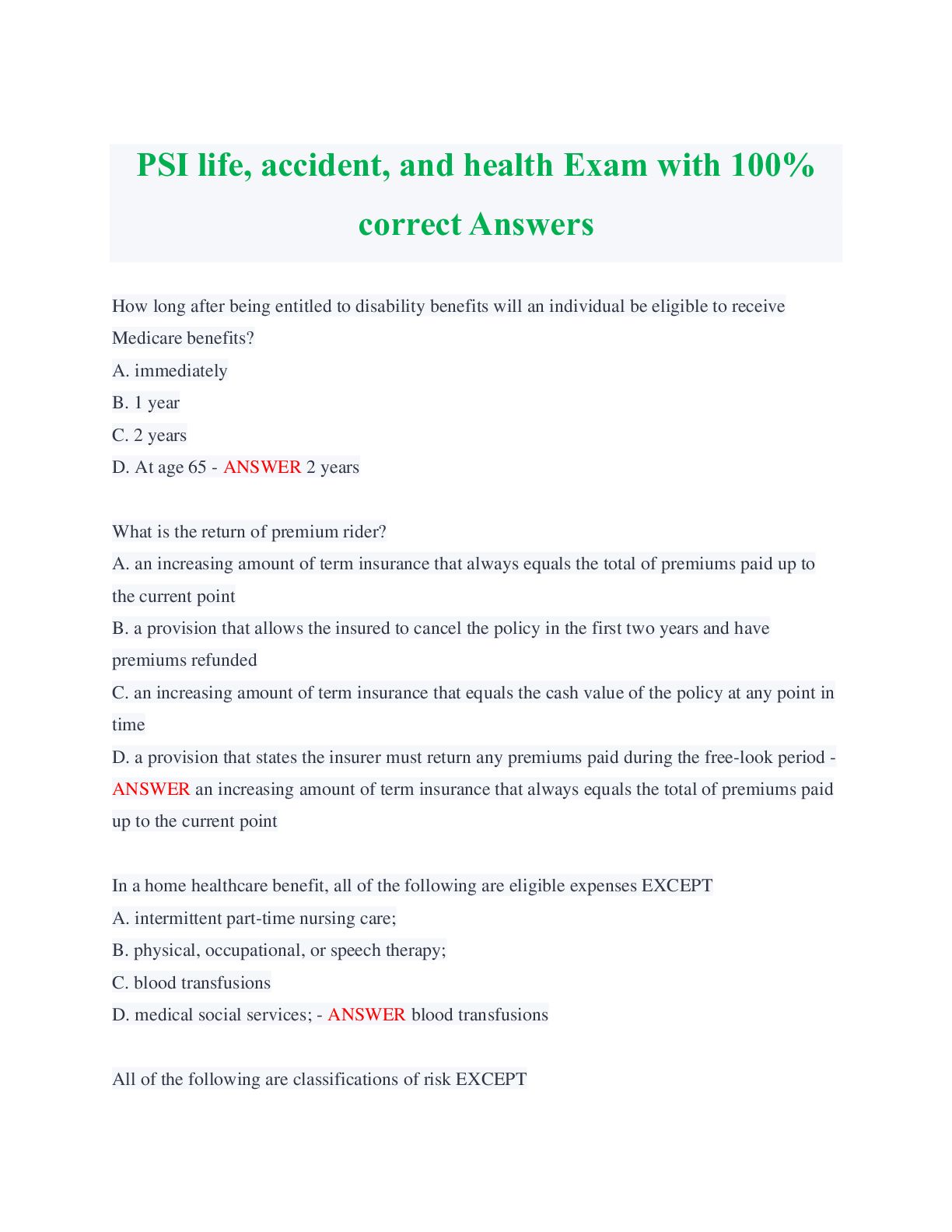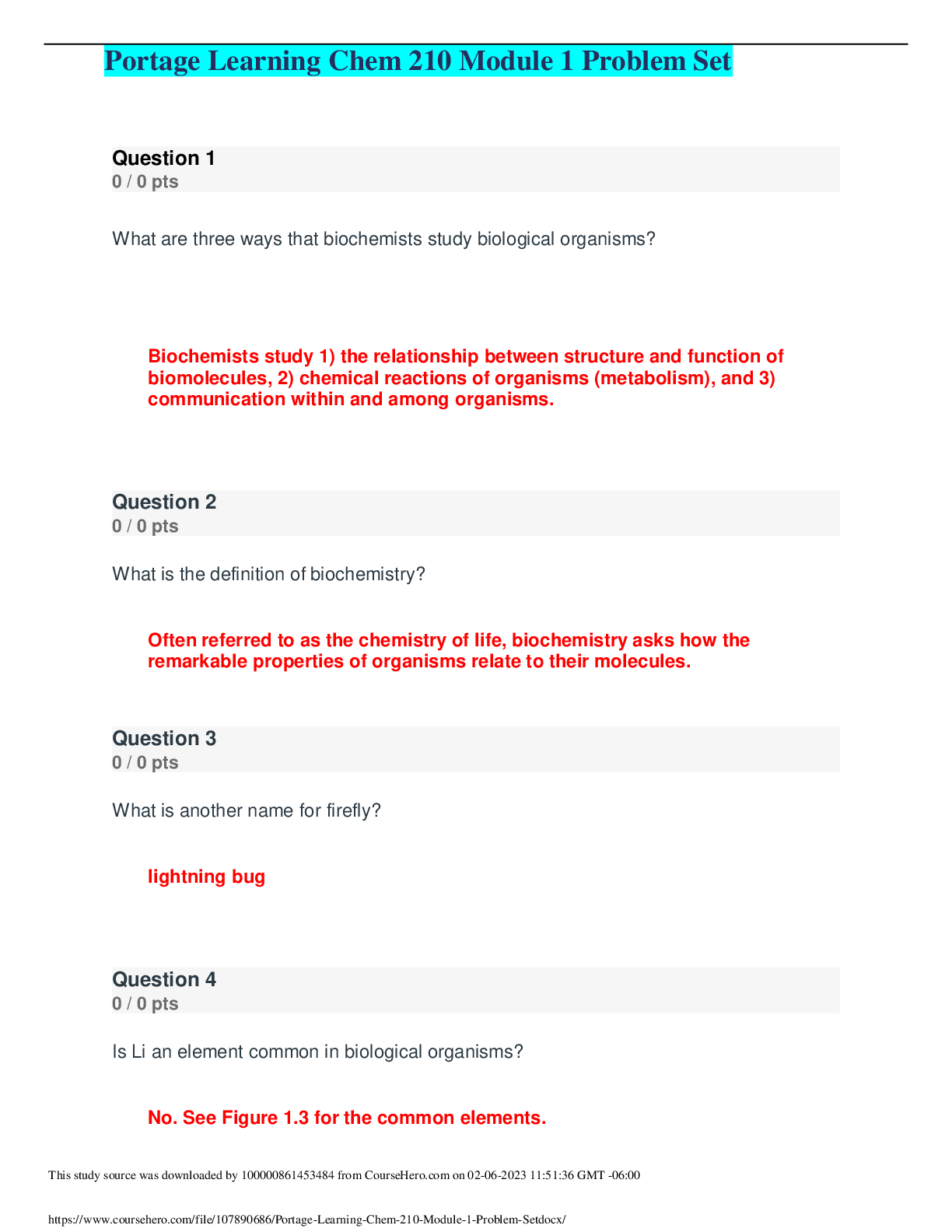Portage Learning Chem 210 Module 2 Exam-2022
Document Content and Description Below
Question 1 3 / 3 pts Scientific Calculator The pH of a solution of 8.9 x 10-12 M NaOH is: A. 8.9 B. 8.9 x 10-12 C. 4.8 D. 11 E. 2.9 A B C D Correct! E [Kw=[H+][OH-] = 1.0 x 10-14; ... [H+][8.9 x 10-12] = 1.0 x 10-14 ;[H+]=890; pH=-log[890]=2.9] Question 2 3 / 3 pts Water is a unique molecule. Which of the following contributes to water’s unique place Portage Learning Chem 210 Module 2 Exam in the chemical world? The geometry of the molecule The polarity of the O-H bonds The ability of water molecules to hydrogen bond The bond angle of water All of the answers are correct ALL OF THE ANSWERS ARE CORRECT What factor contributes to the bent shape of a water molecule? The dipole arrows in a water molecule The unshared electron pairs on the oxygen atom The electronegativity difference between hydrogen and oxygen The unequal electron sharing between hydrogen and oxygen None of the answers are correct THE UNSHARED ELECTRON PAIRS ON THE OXYGEN ATOM Question 4 3 / 3 pts Which diagrams correctly represent a hydrogen bond? A and B A and D B and C C and D A and C A AND C BOTH SHOW A PROTON DONOR AND ACCEPTOR Question 5 3 / 3 pts Scientific Calculator The H+ concentration of a solution is 5.6 x 10-5 What is the pH? -4.25 Correct! 4.25 [ [H+]=5.6 x 10-5; pH=-log[5.6 x 10-5]=4.25] 5.65 -9.75 9.75 4.25 [ [H+]=5.6 x 10-5; pH=-log[5.6 x 10-5]=4.25] If the Ka of an acid is 2.67 x 10-5, what is the pKa? 7.45 12.25 5.26 2.67 4.57 4.57 [pKa = -log(2.67 x 10-5) = 4.57] Question 7 3 / 3 pts List the acids in INCREASING order of strength (weakest to strongest): Nitrous acid (Ka = 4.0 x 10-4); acetic acid (Ka = 1.7 x 10-5); phosphoric acid (Ka = 7.3 x 10-3) Nitrous acid, acetic acid, phosphoric acid Acetic acid, nitrous acid, phosphoric acid Phosphoric acid, nitrous acid, acetic acid Acetic acid, phosphoric acid, nitrous acid None of the above ACETIC ACID, NITROUS ACID, PHOSPHORIC ACID Question 8 3 / 3 pts Elemental bromine (Br2) is a liquid at room temperature. What is the dominant attractive force that exists between Br2 molecules in the liquid? Halogen forces Dipole-dipole forces Hydrogen bonds Covalent bonds London forces LONDON FORCES Which one of the following molecules can form a hydrogen bond? A. HBr B. HCl C. NH3 D. CH4 E. H2 C. NH3 Question 10 3 / 3 pts A hydrogen bond can form between a hydrogen atom bonded to nitrogen, N–H, and ________. C O Cl P Br O Question 11 3 / 3 pts In a bond between P and Cl, there exists a difference in electronegativity resulting in partial positive and partial negative charges. If a dipole arrow were added to this structure, which way would the arrow point? The arrow points from Br toward N The arrow points from N toward Br Two arrows; one pointed in each direction There would not be a dipole arrow in this case. None of the above THE ARROW POINTS FROM N TOWARD BR Question 12 3 / 3 pts The following reaction occurs in glues purchased from hardware stores. Customers use this product to glue plastic together. Epoxy (l) + hardener (l) ⟶ ⟶ Glue (s) + heat given of What is the sign (+ or -) of the change in Δ ΔG and Δ ΔH? A) ΔG is (+) and ΔH is (-) B) ΔG is (-) and ΔH is (-) C) ΔG is (-) and ΔH is (+) D) ΔG is (+) and ΔH is (+) E) None of the above B) ΔG is (-) and ΔH is (-) Question 13 3 / 3 pts Which of the following is the free-energy change of a reaction? A) G B) ΔS C) ΔH D) ΔG E) All of the above D) ΔG Question 14 3 / 3 pts Which of the following is the change in entropy of a reaction? A) ΔG B) ΔE C) ΔH D) ΔS E) None of the above D) ΔS Question 15 3 / 3 pts A B C D E D Question 16 3 / 3 pts Which buffer system is used by the blood to maintain pH balance? Vinegar buffer system Acetic acid buffer system Bicarbonate buffer system Water buffers system Formic acid buffer system BICARBONATE BUFFER SYSTEM Question 17 3 / 3 pts A buffer can neutralize only a certain amount of acid and base. We say that this is its: Buffer limit Buffer capacity Buffer range Buffer maintenance Buffer arena BUFFER CAPACITY Question 18 3 / 3 pts Is a pH of 8.36 acidic, neutral, or basic? Acidic Neutral Basic Both Acidic and Basic Both Neutral and Basic BASIC Question 19 3 / 3 pts The “ion product” is equal to what value? A. 1.0 x 10-14 B. 1.0 x 10-7 C. 2.1 x 10-7 D. 5.6 X 10-13 E. None of the above A. 1.0 x 10-14 Question 20 3 / 3 pts In equilibrium constant expressions, the concentration is expressed in units of _______ as indicated by the brackets [ ]. molarity acid value base value neutral value None of the above MOLARITY Question 21 3 / 3 pts Scientific Calculator A pH = 5.0 indicates a concentration of OH- (in M) of __________. A. 5 B. 10-5 C. 10-9 D. 10-1 E. 101 C. 10-9 Question 22 3 / 3 pts The lysosome has a pH of 5.0. Which of the following weak acids would best work to buffer at pH 5.0? Formic Acid Dihydrogen phosphate Propionic acid Tartaric acid All of these PROPIONIC ACID Question 23 3 / 3 pts Which of the following compounds would not be soluble in water? NaCl Oil Glucose NH3 All of the above would be soluble OIL Question 24 3 / 3 pts The oxygen in water has what type of hybridization? A. sp B. sp2 C. sp3 D. sp3d E. All of the above C. sp3 Question 25 3 / 3 pts Four identical molecules dissolve in water. Each molecule contains both a polar portion and nonpolar portion of structure. The four molecules interact in such a way that the nonpolar sections align. This is an example of the _________. Buffering capacity Hydrophilic effect Hydrogen bonding effect Hydrophobic effect All of the above HYDROPHOBIC EFFECT Question 26 5 / 5 pts (Short Response) How does the strength of a hydrogen bond compare to the strength of a London Force? Also, how about the strength of a hydrogen bond compared to a dipole-dipole force? Briefly comment on these differences. The hydrogen bond strength is between 12 and 16 kcal, while the London force is generally less than 1 Kcal. A dipole-dipole bond usually is from 0.5 to 2.0 kcal. Also, hydrogen bonds are the strongest non-covalent force, which is illustrated by these numbers. Question 27 5 / 5 pts Scientific Calculator Question 28 0 / 5 pts Question 29 5 / 5 pts (Fill in the blanks) At cool temperatures, water vapor turns into liquid water releasing heat in the process. Fill in the missing blanks, below, regarding this process. Please identify your answers by writing “A.” then your answer, “B” then your answer, and so [Show More]
Last updated: 2 years ago
Preview 1 out of 17 pages

Buy this document to get the full access instantly
Instant Download Access after purchase
Buy NowInstant download
We Accept:

Reviews( 0 )
$10.00
Can't find what you want? Try our AI powered Search
Document information
Connected school, study & course
About the document
Uploaded On
Jul 12, 2022
Number of pages
17
Written in
Additional information
This document has been written for:
Uploaded
Jul 12, 2022
Downloads
0
Views
43
























